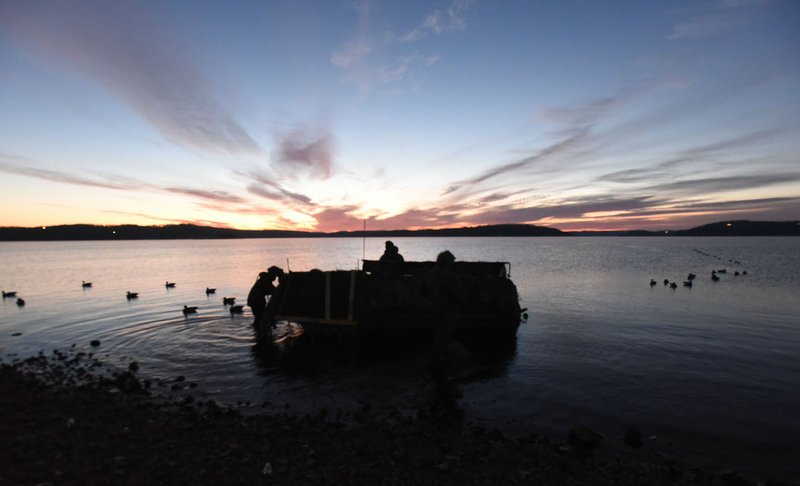Taking a plunge at Beaver Lake in January is a delight for a swimmer with four legs and floppy ears.
Gunner, a Labrador retriever, leaped into the 45-degree water with wide eyes fixed on the mallard that Russell Gardner and his hunting buddies downed before sunrise Jan. 4 on the big lake.
Beaver Lake ducks
Waterfowl hunting is allowed at Beaver Lake along the public shoreline managed by the Army Corps of Engineers, except in developed parks.
Statewide bag limits and regulations apply.
— Source: Staff report
.
Wading through cold water in the dark when it's 17 degrees outside is waterfowl hunting joy for Gardner and other duck hunters who share his passion. Gardner, 25, lives close to Beaver Lake in the Prairie Creek community east of Rogers when he's not in his first year of dental school at the University of Oklahoma.
The timing of duck season is perfect for Gardner's break between semesters. He and Gunner hit the lake nearly every morning, especially in January. That's the best month for Beaver Lake duck hunting, Gardner said.
He's rigged up big time for waterfowl. His aluminum boat and outboard are outfitted with a blind that Gardner designed himself. The blind's metal frame is sturdy and covered with grass and reeds. Some of it is vegetation Gardner picked. Some is store-bought.
Thirty or so duck and goose decoys are ready for duty next to a 12-gauge shotgun, shells, and a coffee thermos that are standard equipment in a duck boat. Gardner has a system that gets the decoys afloat in about 15 minutes.
His boat is nudged close to the bank, parallel to shore. Gardner is settled in and ready to hunt before legal shooting time arrives 30 minutes before sunrise.
There's plenty of room for friends. Gardner and three pals climbed into the boat at 6 a.m. on the 17 degree Thursday morning. Andy Brazle, Harrison Heffley and Silas Heffley, all from Rogers, were decked out in camouflage chest waders and warm camo coats and hats for the pitch-dark boat ride across Beaver Lake.
The four hunters are lifelong friends. Gunner, the retriever, wagged an enthusiastic tail and wore a dog life jacket buckled around his chest. The vest helps keep the pooch warm when he dog paddles through the frigid water to retrieve ducks.
Action varies from hunt to hunt, Gardner said. Some days the hunters' squeeze triggers and send ducks cartwheeling down from the sky. Other mornings, the ducks are no-shows or dodge their best shots.
Beaver Lake and Northwest Arkansas don't get the high number of ducks that make east Arkansas a national waterfowl destination. This corner of the state sits between the Mississippi Flyway, through Arkansas' Delta, and the Central Flyway, which bisects the heart of Oklahoma. Northwest Arkansas gets a scattering of ducks from the flyways, which are major waterfowl migration routes.
Ducks that come to Beaver Lake don't stay long. There's little food. They rest, then move on.
"I've actually seen ducks land, then walk up into the woods looking for something to eat," Gardner said.
The hunter cruises the lake during duck season and looks for areas ducks are using. A flock may be seen on the water close to a point of land or in a pocket. The next morning, Gardner will set up his boat and decoys there, hoping mallards, gadwalls or other ducks will cup wings and glide into shotgun range.
"You've got to do your scouting. Sometimes it doesn't make much sense why ducks go where they go," said Gardner, who's been hunting at Beaver Lake for nine seasons.
The sky was a gorgeous purple with tendrils of dark clouds as daylight broke over the island where Gardner and his friends set up on this cold morning. Beaver Lake seethed with steam in the cold, sending whirling wisps dancing across wind-whipped water.
As shooting hours arrived, three mallards caught the hunters off guard while the quartet settled into Gardner's boat blind. Shotguns popped, but the ducks flew off unscathed.
The next mallard, a lone hen, became the main ingredient for a pot of gumbo. Gunner was in the lake before the echoes of shotgun blasts ceased. The chocolate Lab dog-paddled past a maze of decoys and fetched the mallard that floated on a light chop with orange feet in the air.
By 9:30 a.m. when the hunters called it a morning, the island was awash in sunshine. The temperature reached freezing while the group waded into the shallow water to grab decoys and place them into bags, ready for the next hunt.
"Ideal conditions are 20 degrees and cloudy," Gardner said. Even then ducks can be few and far between. A long time can pass between shots, said Brazle.
"The sure way to miss ducks is to stop paying attention," he said. "You lull yourself to sleep because you haven't seen a duck in 20 minutes."
Or, hunters get caught up in duck-blind chit chat. Next thing that happens is ducks drop out of the sky and nobody notices. By the time shotguns are shouldered, those ducks are clawing for altitude.
Back at the launch ramp, a cold north wind rattled the reeds on Gardner's boat blind. Brazle asked the $64 question: "We going again in the morning?"
Flip Putthoff can be reached at fputthoff@nwadg.com or Twitter @NWAFlip
Sports on 01/16/2018
